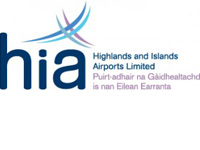Leading regional airport operator, Highlands and Islands Airports Limited (HIAL), is reporting a significant increase in revenue and passenger numbers for the 2017/18 financial year. The private limited company, which is wholly owned by the Scottish Ministers and is responsible for the management and operation of 11 airports across the Highlands and Islands, has boosted revenue to £24.9 million.
It has been another record year for passenger figures across the group with 1.78million passengers travelling through its airports, an increase of 7% on the previous year.Public subsidies received for the year end March 31 totalled £29 million, compared with £36 million the previous year. This funding was used to support airfield operations and fund terminal and airfield enhancements.
The operating loss for the year was £2.2 million compared with £8,000 in 2016/2017. *
The report also illustrates investment of more than £9.9 million to improve air services and passenger experience across the group’s 11 airports: Barra, Benbecula, Campbeltown, Dundee, Inverness, Islay, Kirkwall, Stornoway, Sumburgh, Tiree and Wick.
HIAL chief executive, Inglis Lyon, said the company would continue to work towards ensuring sustainable long-term aviation connectivity for the Highlands and Islands. Mr Lyon said: “Further development, investment and improvement in connectivity for the region will encourage tourism, attract new inward investment and enhance business opportunities. Ultimately, better accessibility will lead growth and help our communities prosper.”
“Over the past year we have achieved some major milestones: 875,000 passengers at Inverness Airport, record numbers at Sumburgh, in Shetland, and new direct routes to Manchester from Stornoway. Each of these achievements illustrate the importance and success of Scotland’s regional airports.
“We welcomed new and additional flights to some of Europe’s busiest transport hubs, meaning businesses across our network can connect with hundreds of destinations around the world through Amsterdam, Gatwick and Heathrow. The benefits for local export businesses, now able to reach new markets across the globe, has been transformational.”
“HIAL operates within a tight budgetary framework. This means we must continue to achieve economies of scale where possible and managing costs without compromising safety in any way. We will continue to be innovative and adaptive, seeking new business opportunities wherever possible.”
Mr Lyon highlighted HIAL’s commitment to investing in new remote towers technology as part of the its air traffic management (ATM) transformation to digital operations. He said: “The ATM 2030 Programme will change the way air traffic services are provided at seven HIAL airports. This will improve our already high safety levels and provide greater resilience to our operation, leading to better services for our customers.
“In other areas, we are cooperating closely with the UK Government on securing vital slots at the proposed runway extension at London Heathrow. We are also focused on delivering our strategic plan to ensure long-term growth, albeit against an uncertain backdrop as Brexit continues to dominate the domestic political and economic landscape.”
HIAL interim chair Lorna Jack, said: “Prioritising aviation service delivery to the communities we serve continues to be our focus. We are working towards delivering a sustainable air transportation service that is fit for the future. “We will continue to put our communities and customers first while endeavouring to sustain an organisation that cares for all its staff.”
Mr Lyon, said the steady increase in passengers across the group demonstrated that demand for aviation services in Scotland continues to grow. “Sumburgh welcomed 63,781 more passengers in 2017/18 with an increase in scheduled flights supporting the oil and gas sector and an increase in offshore traffic, while Tiree’s numbers grew by 8%.
“Inverness passenger numbers increased by 46,855 for the financial year, illustrating the airport’s importance in terms of global connectivity and as a driver for the Highland region and economy. The continuation of the airport’s Heathrow and Amsterdam Schiphol flights helped to boost numbers to 875,873.”
Strong demand on flights from Glasgow to Barra, Islay and Kirkwall saw increases in passenger numbers at these airports, with Kirkwall attracting 195,982 passengers.
Benbecula and Campbeltown airports logged 4.6% and 3.7% year-on-year growth respectively.
Passenger numbers declined at Wick John O’Groats (-16.8%), due in part to a continued reduction in demand from energy sector services to-and-from Aberdeen, while Dundee (-43.4%) also recorded a reduction in numbers due to the loss of KLM’s Dundee to Amsterdam route.
*This includes accounting for the amendments to pension costs year-on-year in order that HIAL’s future pension obligations are met. These pension costs are in accordance with the accounting standard IAS19. They are a non-cash item and without them HIAL would have broken even
